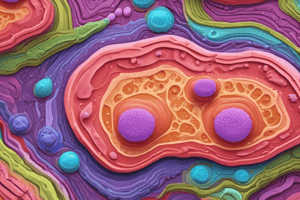Podcast
Questions and Answers
Where are the epithelial tissues found?
Where are the epithelial tissues found?
They cover the body's surfaces and line hollow organs and body cavities. They also form the secretion portion of the glandular tissue.
Describe the basic shape of the squamous epithelial cell.
Describe the basic shape of the squamous epithelial cell.
They are flat and arranged like tiles. The nucleus is in the center.
Describe the basic shape of the cuboidal epithelial cell.
Describe the basic shape of the cuboidal epithelial cell.
They are as tall as they are wide and are shaped like cubes or hexagons, with the nucleus in the center.
Describe the basic shape of the columnar epithelial cell.
Describe the basic shape of the columnar epithelial cell.
What is the apical surface of the epithelial tissue? What is the function of microvilli and cilia located on this surface?
What is the apical surface of the epithelial tissue? What is the function of microvilli and cilia located on this surface?
Describe the positional relationship between the epithelial surface cells, basal surface, basement membrane, and connective tissue.
Describe the positional relationship between the epithelial surface cells, basal surface, basement membrane, and connective tissue.
What is the arrangement of the simple epithelial tissue?
What is the arrangement of the simple epithelial tissue?
What is the arrangement of the stratified epithelial tissue?
What is the arrangement of the stratified epithelial tissue?
What is the arrangement of the transitional epithelial tissue?
What is the arrangement of the transitional epithelial tissue?
What is Simple Squamous Epithelium?
What is Simple Squamous Epithelium?
What is Stratified Squamous Epithelium?
What is Stratified Squamous Epithelium?
Flashcards are hidden until you start studying
Study Notes
Epithelial Tissues Overview
- Epithelial tissues cover body surfaces, line hollow organs, and body cavities.
- They form the secretion portion of glandular tissue.
Types of Epithelial Cells
- Squamous Cells: Flat, tile-like arrangement with a central nucleus.
- Cuboidal Cells: Equal height and width, cube or hexagon-shaped with a central nucleus.
- Columnar Cells: Taller than wide, resembling columns, with an oval nucleus near the basal surface.
Apical Surface Functions
- The apical surface is the most superficial layer of epithelial tissue.
- It may contain cilia or microvilli:
- Cilia: Move mucus or other substances across the surface.
- Microvilli: Increase surface area for absorption.
Structural Relationships
- Surface cells face the apical surface; the basal surface is formed by the deepest layer of cells.
- The basement membrane anchors the basal layer to underlying connective tissue.
Arrangements of Epithelial Tissue
- Simple Epithelium: Single layer of cells facilitating diffusion, osmosis, filtration, secretion, and absorption.
- Stratified Epithelium: Composed of two or more layers, providing protection against stress and strain.
- Transitional Epithelium: A type of stratified epithelium with surface cells that change shape depending on the organ's functional state, found only in the urinary system.
Specific Types of Epithelial Tissue
- Simple Squamous Epithelium: Composed of a single layer of flat cells, lining the cardiovascular and lymphatic systems and forming serous membranes, involved in filtration, diffusion, osmosis, and secretion.
- Stratified Squamous Epithelium: Multiple layers of flat surface cells found in the skin, mouth, esophagus, epiglottis, pharynx, vagina, and tongue, primarily serving a protective function.
Studying That Suits You
Use AI to generate personalized quizzes and flashcards to suit your learning preferences.




